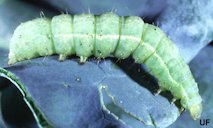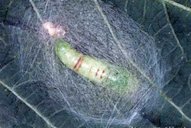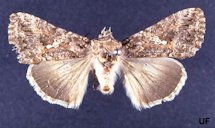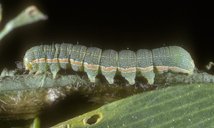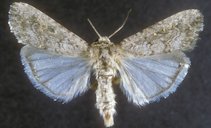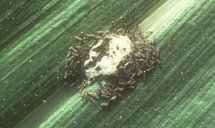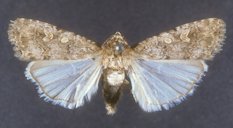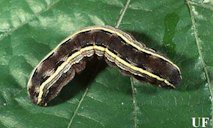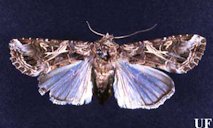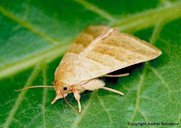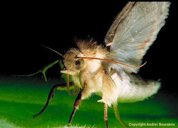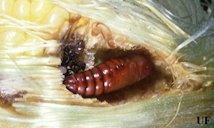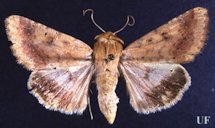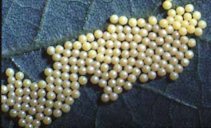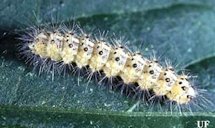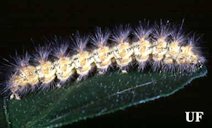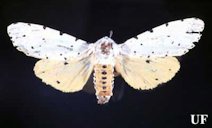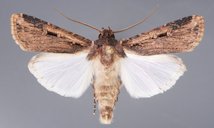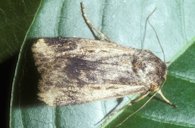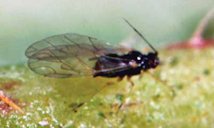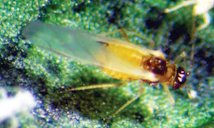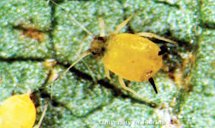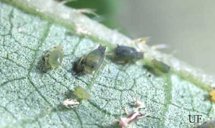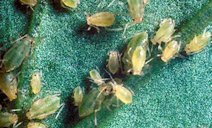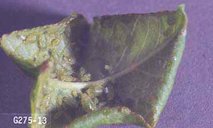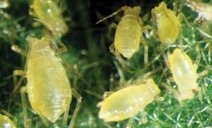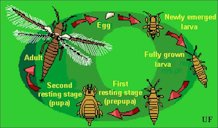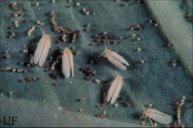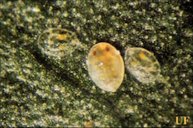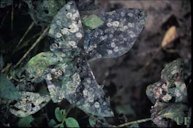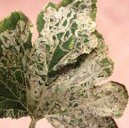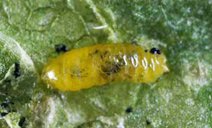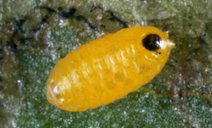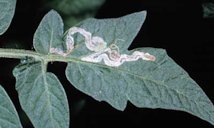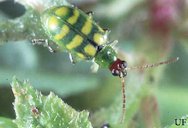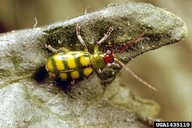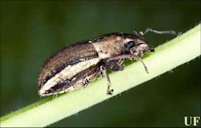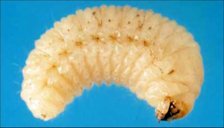| Watermelon Pests | ||||||||||||||||||||||||||||||||||||||||||||||||||||||||||||||||||||||||||||||||||||||||||||||||||||
|---|---|---|---|---|---|---|---|---|---|---|---|---|---|---|---|---|---|---|---|---|---|---|---|---|---|---|---|---|---|---|---|---|---|---|---|---|---|---|---|---|---|---|---|---|---|---|---|---|---|---|---|---|---|---|---|---|---|---|---|---|---|---|---|---|---|---|---|---|---|---|---|---|---|---|---|---|---|---|---|---|---|---|---|---|---|---|---|---|---|---|---|---|---|---|---|---|---|---|---|---|
| Back to Watermelon Page 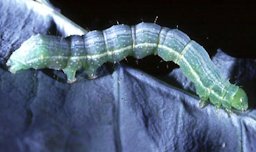 Fig. 1  Early instar larva of the cabbage looper 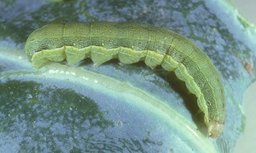 Fig. 5  Larva of the beet armyworm  Fig. 8  Larva of fall armyworm, note light-colored inverted "Y" on front of head 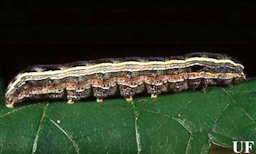 Fig. 12  Lateral view of a larva of the yellowstriped armyworm 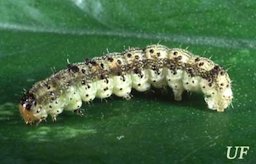 Fig. 15  Larva of the tobacco budworm Fig. 18 Larva of the corn earworm 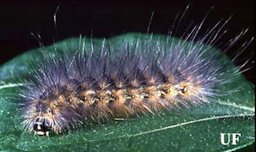 Fig. 21  Mature saltmarsh caterpillar 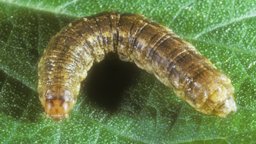 Fig. 28  Granulate cutworm  Fig. 31  Wild lettuce aphid Uroleucon pseudambrosia 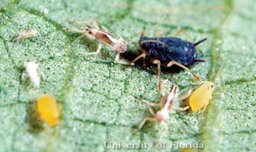 Fig. 32  Nymps (mixed ages) and dark form of wingless adult of melon aphids  Fig. 39  Adult green peach aphid 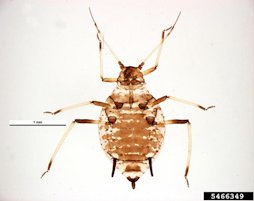 Fig. 43  Cowpea aphid 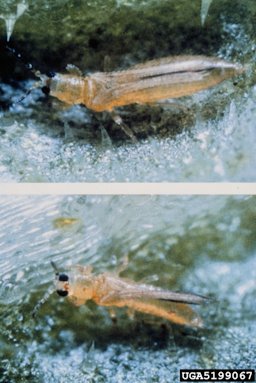 Fig. 46  Adults of melon Thrips palmi Karny 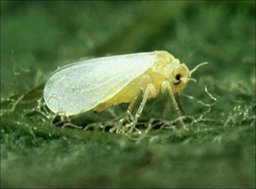 Fig. 50  Adult Bemisia argentifolii or B. tabaci  Fig. 54  Leaf miner fly collected from chard leaves in Howell Collective Garden 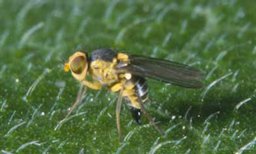 Fig. 58  Adult American serpentine leafminer, Liriomyza trifolii 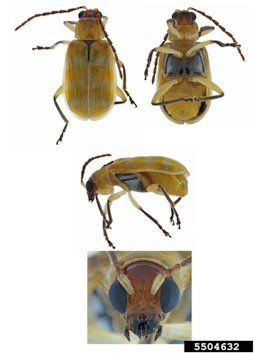 Fig. 62  Multiple views of the banded cucumber beetle, Diabrotica balteata 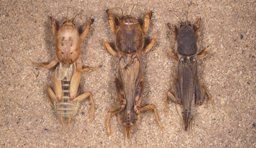 Fig. 65  Three mole cricket species: shortwinged mole cricket, Scapteriscus abbreviatus (left); tawny mole cricket, S. vicinus (center); southern mole cricket, S.borellii (right) 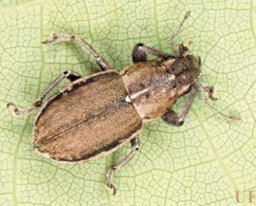 Fig. 67  Dorsal view of an adult female whitefringed beetle, Naupactus sp.
|
Insects
and
mites can cause severe problems in the production of watermelon,
squash, cucumber, and cantaloupe either through direct damage to the
crop or through transmission of disease agents, such as the aphid-borne
mosaic viruses. Common pests of cucurbits are described below. The
importance of a particular insect will vary by region and by crop. For
example root maggots are more important in North Florida and melon
thrips in South Florida. Pickleworm and melonworm rarely attack
watermelon. 1 The principal insect and mite pests on watermelons in Florida are aphids, rindworms (caterpillars feeding on the rind, including beet and fall armyworms, cabbage looper, tobacco budworm, corn earworm, saltmarsh caterpillar, and others), whiteflies, and thrips. Occasional or minor arthropod pests include seedcorn maggots, cutworms, leafminers, cucumber beetles, mole crickets, wireworms, white-fringed beetle larvae, mites, and flea beetles. Leafhoppers and fleahoppers, grasshoppers, omnivorous leafrollers, plant bugs (including lygus bugs and stink bugs), and squash bugs may occasionally be seen on watermelons but are not economically damaging (Maynard 2003; Hopkins 2003; Webb 2010; Webb 1995; Webb, Kok-Yokomi, and Voegtlin 1994). 3 Ringworm Complex Any caterpillars that feed on watermelon rinds are called rindworms, including beet armyworm (Spodoptera exigua), fall armyworm (Spodoptera frugiperda), yellow-striped armyworm (Spodoptera ornithogalli), cabbage looper (Trichoplusia ni), tobacco budworm (Heliothis virescens), corn earworm (Helicoverpa zea), saltmarsh caterpillar (Estigmene acrea), and granulate cutworm (Feltia subterranea). Many rindworms also feed on the plant’s foliage and stems, but the greatest damage occurs from feeding on the rind, which directly reduces the fruit’s quality and marketability. Rindworms generally scar the surface of the fruit in irregular patterns, rather than boring into it. Larger caterpillars inflict greater damage, and management is generally easier when the caterpillars are smaller. Rindworms are often found on the underside or the least exposed parts of the watermelon (Webb 2003). 3 Cabbage looper (Fig. 1) Trichoplusia ni (Hubner) The adults are night-flying moths with brown, mottled forewings marked in the center with a small, silver figure eight. They lay their eggs (small, ridged, round, greenish-white) singly on both upper and lower leaf surfaces. The eggs hatch into larvae that are green with white stripes running the length of their bodies. Cabbage loopers move in a characteristic looping motion, alternately stretching forward and arching its back as it brings the back prolegs close to its front legs. After feeding for two to four weeks, the caterpillar, about 1.25 inches long when fully grown, spins a cocoon and pupates. The adults emerge 10 days to two weeks later. There can be several generations per year depending on climate. 1
Beet armyworm (Fig. 5) Spodoptera exigua (Hubner) The highly mobile adult moth has dark forewings with mottled lighter markings and hind wings thinly covered with whitish scales. Each female can lay over 600 eggs, generally in masses of about 100 on the undersides of leaves in the lower plant canopy. Very young caterpillars feed in groups and then disperse as they grow older (third instar). The dull green caterpillars have wavy, light-colored stripes lengthwise down the back and broader stripes on each side. After feeding from one to three weeks, they construct a cocoon and pupate, emerging as adults about one week later. Beet armyworm survives the winter in South Florida and can complete many generations a year there. From South Florida, adults migrate into North Florida and other parts of the Southeast. 1 Caterpillars feed on stems and foliage, but their feeding on the rind of the watermelon causes the most economically important damage. The irregularly-shaped white to tan blotches left after the caterpillar feeds on the upper layers of the rind make the fruit less marketable. 1
Fall Armyworm (Fig. 8) Spodoptera frugiperda (J. E. Smith) The fall armyworm is native to the tropical regions of the western hemisphere from the United States to Argentina. It normally overwinters successfully in the United States only in southern Florida and southern Texas. The fall armyworm is a strong flier, and disperses long distances annually during the summer months. It is recorded from virtually all states east of the Rocky Mountains. However, as a regular and serious pest, its range tends to be mostly the southeastern states. In 2016 it was reported for the first time in West and Central Africa, so it now threatens Africa and Europe. 5
Fig. 9. Hatching first instar larvae of the fall armyworm Fig. 10. Typical adult male Fig. 11. Typical adult female Yellowstriped Armyworm (Fig. 12) Spodoptera ornithogalli (Guenee) Larvae damage plants principally by consumption of foliage. The small, gregarious larvae tend to skeletonize foliage but as the larvae grow and disperse they consume irregular patches of foliage or entire leaves. These species are very general feeders, reportedly damaging many crops. Among vegetable crops injured are asparagus, bean, beet, cabbage, cantaloupe, carrot, corn, cucumber, lettuce, onion, pea, potato, rhubarb, rutabaga, salsify, sweet potato, tomato, turnip, and watermelon. 6
Fig. 13. Dorsal view of a larva of the yellowstriped armyworm Fig. 14. Adult Tobacco budworm (Fig. 15) Heliothis virescens
Fig. 16. An adult tobacco budworm Fig. 17. A closeup of an adult Corn earworm (Fig.18) Helicoverpa zea (Boddie) Corn earworm has a wide host range; hence, it is also known as "tomato fruitworm," "sorghum headworm," "vetchworm," and "cotton bollworm." In addition to corn and tomato, perhaps its most favored vegetable hosts, corn earworm also attacks artichoke, asparagus, cabbage, cantaloupe, collard, cowpea, cucumber, eggplant, lettuce, lima bean, melon, okra, pea, pepper, potato, pumpkin, snap bean, spinach, squash, sweet potato, and watermelon. The number of generations is usually reported to be one in northern areas such as most of Canada, Minnesota, and western New York; two in northeastern states; two to three in Maryland; three in the central Great Plains; and northern California; four to five in Louisiana and southern California; and perhaps seven in southern Florida and southern Texas. The life cycle can be completed in about 30 days. 7
Fig. 19. Pupa of the corn earworm Fig. 20. Adult Saltmarsh caterpillar (Fig. 21) Estigmene acrea (Drury) The saltmarsh caterpillar, Estigmene acrea (Drury), is a native insect found throughout the United States. Its distribution extends to Central America, and in Canada it has damaged crops in Ontario and Quebec. As a pest, it is most common in the southern United States, particularly the southwest. Larvae are defoliators. Young larvae feed gregariously and skeletonize foliage. Older larvae are solitary and eat large holes in leaf tissue. Older larvae may disperse long distances in search of food, sometimes moving in large numbers. Commonly this is associated with maturation of cotton or weeds in the autumn. Thus, these caterpillars tend to be damaging to fall-planted crops. 8
Fig. 22. Eggs of the saltmarsh caterpillar Fig. 23. Aggregation of young saltmarsh caterpillars Fig. 24. Young saltmarsh caterpillar Fig. 25. Intermediate stage Fig. 26. Adult female Fig. 27. Adult male Further Reading Cabbage Looper, Trichoplusia ni (Hubner), University of Florida pdf Beet armyworm, Spodoptera exigua (Hubner), University of Florida pdf Fall armyworm, Spodoptera frugiperda (J.E. Smith), University of Florida pdf Yellowstriped armyworm, Spodoptera ornithogalli (Guenee), University of Florida pdf Tobacco budworm, Heliothis virescens, University of Florida pdf Corn earworm, Helicoverpa zea (Boddie), University of Florida pdf Saltmarsh caterpillar, Estigmene acrea (Drury), University of Florida pdf (Archived) Granulate Cutworm (Fig. 28) Feltia subterranea (Fabricius) The granulate cutworm, Feltia subterranea (Fabricius) is the most commonly occurring cutworm in Florida, though it is rarely numerous enough to be a major pest. It is nocturnal through most of its life, and lacks distinctive features in the larval and adult stage, so it often is overlooked, and its activities and damage are not fully appreciated. 4
Fig. 29,30. Adult of the granulate cutworm Further Reading Granulate cutworm, Feltia subterranea (Fabricius), University of Florida pdf Aphids Aphids attacking watermelon include melon aphid (Aphis gossypii), green peach aphid (Myzus persicae), cowpea aphid (A.craccivora), spirea aphid (A. spiraecola), A. middletonii, and Uroleucon pseudambrosiae (Fig. 31) , among others. Aphids constitute the principal insect pest of watermelons in Florida, primarily because of their role in virus transmission. Melon aphid, green peach aphid, and cowpea aphid feed and reproduce on watermelons and other cucurbits. The other aphids listed are important virus vectors but do not colonize watermelons. Melon aphid is the most abundant aphid colonizing watermelons in Florida. 3 Aphids feed by piercing plant tissue with their needle-like mouthparts (stylets) and sucking out water and nutrients from the plant’s vascular system. Evidence of damage includes thickening, crumpling, and downward curling leaves caused by feeding damage and injury from toxins in the saliva injected into plant tissue during feeding. Heavy aphid attack may kill very young plants. Aphids also deposit large amounts of honeydew on the plant surface, which encourages the growth of sooty mold. Aphid populations can increase rapidly in Florida because of a short life cycle and reproduction by live birth (Stansly 2011). 3 Melon Aphid (Fig. 32) Aphis gossypii Glover Melon aphids are soft-bodied insects, almost egg-shaped when viewed from above. The largest ones are not much longer than one-sixteenth of an inch in length. Their color can vary from pale yellow to dark green to almost black. A pair of small tube-like structures called cornicles extends backward and upward from the posterior of the aphid, above a small tail-like structure (cauda). The first individuals to colonize a plant will usually have wings, but then wingless aphids become the dominant form until crowding occurs or the plant deteriorates. Then winged aphids will be produced again to disperse to other plants. 1 On watermelon and cantaloupe, the first sign of aphid damage is a downward curling and crumpling of the leaves, which also appear thickened and may glisten with sticky honeydew. On squash, aphids are often found on lower leaves and on flower buds and flowers. If plants are heavily attacked when very young they may be killed. This aphid is also involved in the spread of several viruses that affect all cucurbits. 1
Fig. 33. Winged adult (black morph) melon aphid Fig. 34. Winged adult (yellow morph) Fig. 35. Wingless adult (yellow morph) Fig. 36. Melon aphids Fig. 37. Melon aphids, A. gossypii Glover, tended by ants Green Peach Aphid (Fig. 39) Myzus persicae (Sulzer)
Fig. 40. Female adult green peach aphids Fig. 41. Colony of green peach aphid with several life stages Fig. 42. Nymphs of the green peach aphid Cowpea Aphid (Fig. 43) Aphis craccivora Koch
Fig. 44. Cowpea aphid nymphs Fig. 45. Infested bud with adults and nymphs Many of the natural enemies known to be effective against other aphids also attack melon aphid: ladybirds (Coleoptera: Coccinellidae), syrphid flies (Diptera: Syrpidae), and braconid wasps (Hymenoptera: Braconidae). Ants are commonly found associated with melon aphid but they are there to collect honeydew, and may even hinder predation by other insects. The wasp Lysiphlebus testaceipes (Cress) (Hymenoptera: Braconidae) is especially effective, sometimes causing up to 99% parasitism. Fungi also are sometimes observed to affect melon aphid. 2 Further Reading Melon Aphid or Cotton Aphid, Aphis gossypii Glover, University of Florida pdf Greeen Peach Aphid, Mysus persicae (Sulzer), University of Florida pdf Melon Thrips (Fig. 46) Thrips palmi Karny Thrips palmi is by far the most serious thrips pest of watermelon. So far, in the United States, it has been reported only in Hawaii and South Florida where it attacks a number of vegetable crops. In watermelon, its feeding causes bronzing of foliage and destruction of vine tips, leading to limited canopy development. Tobacco thrips has been mainly reported as a pest of seedling watermelon plants in Central and North Florida. Feeding damage to developing leaves leads to scarring that is similar to abrasion by blowing sand. 1
Fig. 47. Larvae of melon thrips, Thrips palmi Karny Fig. 48. Bean leaf damage caused by the melon thrips, close-up of the bronze coloring effect Fig. 49. Typical thrips life cycle Further Reading Melon Thrips, Thrips palmi Karny Guide, University of Florida pdf Melon Thrips, Thrips palmi Karny, University of Florida pdf Whiteflies Whiteflies found infesting Florida watermelons include silverleaf whitefly (Bemisia argentifolii), sweet potato whitefly (B. tabaci), and greenhouse whitefly (Trialeurodes vaporariorum). Whiteflies damage watermelon plants by removing plant sap, depleting the plant of needed nutrients. On some hosts, whiteflies cause severe damage by transmitting plant viruses. On watermelons, whiteflies have been reported to transmit squash leaf curl and lettuce infectious yellows, but these viruses do not presently occur in Florida. In Florida, the principal damage to watermelons inflicted by whiteflies is caused by feeding, which greatly reduces the plants’ vigor under heavy infestations (Webb 2003). 3 Silverfeaf Whitefly (Fig. 50) Bemisia tabaci (Gennadius) of Bemisia argentifolii Bellows & Perring Its common name is the silverleaf whitefly, because of its unique ability to induced silverleaf disorder in squash. Silverleaf whitefly can affect the crop directly by its feeding and by acting as a vector of viruses such as Squash vein yellowing virus, Cucurbit leaf crumple virus, and Cucurbit yellow stunting disorder virus, which have been reported in Florida in the last five years. Squash vein yellowing virus is responsible for a devastating disease of watermelon, known as watermelon vine decline. Plants often die shortly before or during harvest, and fruit show necrosis of the rind when cut open. When whiteflies are very numerous, the sticky honeydew they produce supports the growth of sooty mold on leaves. Squash and pumpkin are susceptible to silverleaf, a disorder caused by feeding of immature stages. For unknown reasons, epidermal cells separate from the cells below them, leaving air spaces, which make the leaves appear silver. New growth will be normal once whiteflies are controlled. 1
Fig. 51. Newly laid eggs of Bemisia are pale yellow while those about to hatch are dark brown Fig. 52. Red-eyed nymphal or "pupal" stage of Bemisias Fig. 53. Sooty mold developing on soybean leaves covered with Bemisia honeydew Further Reading Sweetpotato Whitefly B Biotype of Silverleaf Whitefly, University of Florida pdf Leafminers Leafminers (Liriomyza sativae and L. trifolii) are occasionally a major pest of watermelons in South Florida. Infestations are often more severe late in the season. Under heavy infestations, leaves may be nearly covered with mines, and defoliation late in the season can result in sunscald damage on the fruit. Adequately managing leafminer populations in watermelon seedlings is particularly important because the mines can serve as entry points for the fungus that causes gummy stem blight, an important watermelon disease in Florida (Hochmuth and Elmstrom 1992; Webb 2003). 3 Vegetable Leafminer (Fig. 54) Liriomyza sativae (Blanchard)
Fig. 55. L. sativae pupa Fig. 56. Larva Fig. 57. Vegetable leafminer damage American Serpentine Leafminer (Fig. 58 ) Liriomyza trifolii (Burgess)
Fig. 59. Larva of the American serpentine leafminer Fig. 60. Pupa Fig. 61. Mine in tomato leaf caused by the American serpentine leafminer Further Reading Vegetable Leafminer, Liriomyza sativae Blanchard, University of Florida pdf American Serpentine Leafminer, Liriomyza trifolii (Burgess), University of Florida pdf Cucumber Beetles In Florida, cucumber beetles include banded cucumber beetle (Diabrotica balteata), striped cucumber beetle (Acalymma vittata), and spotted cucumber beetle (D. undecimpunctata howardi). These beetles occasionally feed on watermelons in Florida to the degree that control measures become necessary. Banded cucumber beetle is more prevalent in South Florida, while spotted cucumber beetle is most common in North Florida. Striped cucumber beetle is seen only occasionally, primarily in western and northern Florida (Watson and Tissot 1942). 3 Banded Cucumber Beetle (Fig. 62) Diabrotica balteata LeConte The banded cucumber beetle is nearly omnivorous, and in addition to numerous plants being attacked, all parts of the plant are injured. Damage may occur to foliage, blossoms, silk, kernels, the plant crown, and roots. Larvae feed only on the roots. The most frequent forms of serious injury are defoliation by adults and root feeding on plant seedlings by larvae. Some of the most serious injury results from larval feeding on sweet potato roots. Banded cucumber beetle is known as a vector of virus diseases in beans, and larval feeding might increase the incidence and severity of Fusarium wilt. 8
Fig. 63. Adult banded cucumber beetle, D. balteata LeConte Fig. 64. Adult banded cucumber beetle Further Reading Banded cucumber beetle, Diabrotica balteata LeConte, University of Florida pdf Mole Crickets (Fig. 65) Scapteriscus spp. Mole crickets (Scapteriscus spp.) occasionally present a problem to watermelon producers in Florida. They damage young seedlings by feeding on and tunneling in and around the roots often girdling the stems at their base. Their presence can be confirmed easily by the tunnels they make just below the soil surface. Mole crickets are active at night, particularly on warm nights when soil is moist, and they are rarely seen during the day (Schuster and Price 1992). 3
Fig. 66. Tunnels formed by mole crickets burrowing near the soil surface Further Reading Shortwinged Mole Cricket, Scapteriscus abbreviatus Scudder; Southern Mole Cricket, Scapteriscus borellii Giglio-Tos; and Tawny Mole Cricket, Scapteriscus vicinus Scudder, University of Florida pdf Wireworms Conoderus spp. Wireworms (Conoderus spp.), the larvae of click beetles, are among the most destructive of soil insect pests. Conoderus spp. wireworms, including C. rudis, C. amplicollis (Gulf wireworm), C. falli (southern potato wireworm), and C. verpertinus (tobacco wireworm), are the most common on vegetable crops in Florida. Wireworms cause the greatest damage to germinating seeds, and transplants are generally less susceptible. In addition to attacking seeds before or at germination, wireworms can bore into the tap root and tunnel up the stem or feed on smaller roots of seedlings. They can cause sudden stand reductions by quickly attacking young seedlings, causing wilting, stunting, and death. Click beetles lay their eggs in the soil near plant roots, and on hatching, the wireworms feed on the nearby roots. Wireworms may spend up to several years in the soil in the larval stage and may be present at a soil depth of 1–5 feet (0.3–1.5 meters) (Brinen 2003; Stansly 2011). Similar to mole crickets, wireworms are more numerous in pasture and grass, so watermelons planted to land previously used for pasture are likely to experience greater wireworm problems. Chemical controls for wireworms must be applied before or at planting. 3 White-fringed Beetle (Fig. 67) Graphognathus) spp. White-fringed beetle (Graphognathus spp.) is an occasional pest on watermelons and other crops in North Florida. It prefers cotton, peanut, okra, soybean, cowpea, sweet potato, beans, and peas, but most vegetable and field crops are attacked by this pest. Larvae (grubs) feed on roots, tubers, underground stems, and dead plant matter, and can inflict serious damage to the taproot by boring into it. In addition to directly killing the seedling, grub damage to roots leaves the plant susceptible to root infections. White-fringed beetle grubs may damage plants in only a few scattered areas within a field or may affect nearly all plants within a field. Adults feed on leaves of host plants, cutting out notches along the leaf margins. They lay eggs in the soil at the plant base, and the grub stage can live up to two years in the soil. Currently no insecticides are effective against the grub, although several insecticides are available for adult white-fringed beetles. The presence of white-fringed beetle grubs is best determined by the crop history of the land. Watermelons should not be planted to land infested with white-fringed beetle grubs (Dixon 1988). 3
Fig. 68. Lateral view of an adult female whitefringed beetle, Naupactus spp. Fig. 89. Larva of the whitefringed beetle Further Reading Whitefringed beetle, Naupactus (=Graphognathus) spp., University of Florida pdf Spider Mites Spider mites, the most common type of mite affecting crop plants, are occasionally pests on watermelons in Florida. They feed on the underside of leaves, primarily along the midribs and lateral veins. After piercing the leaf surface, they suck up the plant’s sap. Mite feeding causes watermelon plants to turn pale, then yellow, and eventually brown, and the plant appears dusty. Under severe infestations, foliage dries up and dies. When many mites are present, silken webs and white flakes of molted skin can be observed on the leaf surface. Mites move from one plant to another by parachuting through the air on their webs, using the wind. When their path is interrupted by an obstacle, they crawl down and seek out host plants. Infestations begin along edges of fields and close to high objects such as fences or trees. 3 Further Reading Insect Management of Cucurbits (Cucumber, Squash, Cantaloupe and Watermelon), University of Florida pdf Florida Crop/Pest Management Profile: Watermelon, University of Florida pdf |
|||||||||||||||||||||||||||||||||||||||||||||||||||||||||||||||||||||||||||||||||||||||||||||||||||
| Bibliograph 1 Webb, S. E. "Insect Management for Cucurbits (Cucumber, Squash, Cantaloupe, and Watermelon." Entomology and Nematology Dept., UF/IFAS Extension, ENY-460 (IG168), Original pub. Aug. 2001, Revised Sept. 2007, May 2010, June 2013, Feb. 2017, and July 2020, Reviewed July 2023, AskIFAS, edis.ifas.ufl.edu/in168. Accessed 28 July 2017, 18 Sept. 2018, 11 May 2022, 25 Jan. 2024. 2 Capinera, John L. "Melon Aphid or Cotton Aphid, Aphis gossypii Glover." Entomology & Nematology Department, UF/IFAS Extension, ENY-173 (IN330), Original pub. Nov. 2000, Revised June 2018, and Dec. 2021, AskIFAS, edis.ifas.ufl.edu/in330. Accessed 18 Sept. 2018, 12 May 2022. 3 Elwakil, Wael M., and Mark A. Mossler. "Florida Crop/Pest Management Profile: Watermelon." Horticultural Sciences Dept., UF/IFAS Extension, CIR1236, Original pub. Oct. 1999, Revised Oct. 2000, July 2004, Aug. 2013, July 2017, and 2021, AskIFAS, edis.ifas.ufl.edu/pi031. Accessed 28 July 2017, 31 July 2019, 12 May 2022. 4 Capinera, John L. "Granulate cutworm, Feltia subterranea (Fabricius)." Entomology and Nematology Dept.,UF/IFAS Extension, EENY-559, Original pub. May 2013, Revised Jan. 2923, AskIFAS, edis.ifas.ufl.edu/in997. Accessed 18 Sept. 2018, 12 May 2022, 25 Jan. 2024. 5 Capinera, John L. "Fall armyworm, Podoptera frugiperda (J. E. Smith). (Insecta: Lepidoptera: Noctuidae)." Entomology and Nematology Dept., UF/IFAS Extension, EENY098, Original pub. July 1999, Revised Nov. 2005 and May 2017, Reviewed June 2020, AskIFAS, edis.ifas.ufl.edu/in168. Accessed 18 Sept. 2018, 12 May 2022, 25 Jan. 2024. 6 Capinera, John L. "Yellowstriped Armyworm, Spodoptera ornithogalli (Guenee) (Insecta: Lepidoptera: Noctuidae)." Featured Creatures from the Entomology and Nematology Dept., UF/IFAS Extension, EENY-216, Original pub. July 2001, Revised Nov. 2005, June 2017, and Oct. 2023, AskIFAS, edis.ifas.ufl.edu/in373. Accessed 18 Sept. 2018, 12 May 2022, 25 Jan. 2024. 7 Capinera, John L. "Corn Earworm, Helicoverpa (=Heliothis) zea (Boddie) (Lepidoptera: Noctuidae." Featured Creatures from the Entomology and Nematology Dept., UF/IFAS Extension, EENY-145 (IN302), Original pub. July 2000, Revised June 2017, Reviewed June 2020, AskIFAS, edis.ifas.ufl.edu/in302. Accessed 18 Sept. 2018, 12 May 2022. 8 Capinera, John L. "Saltmarsh Caterpillar, Estigmene acrea (Drury) (Insecta: Lepidoptera: Arctiidae)." Entomology and Nematology Dept., UF/IFAS Extension, EENY218, Original pub. date July 2001, Revised Mar. 2013, and Jan. 2023, AskIFAS, Archived, edis.ifas.ufl.edu/in302. Accessed 18 Sept. 2018, 12 May 2022, 25 Jan. 2024. Photographs Fig. 1,2,3,4 Capinera, John L. "Cabbage looper, Trichoplusia ni (Hubner)." UF/IFAS Extension, AskIFAS, edis.ifas.ufl.edu. Accessed 18 Oct. 2014. Fig. 5,6,7 Capinera, John L. "Beet armyworm, Spodoptera exigua (Hubner)." UF/IFAS Extension, AskIFAS, edis.ifas.ufl.edu. Accessed 18 Oct. 2014. Fig. 8,10,11 Capinera, John L. "Fall armyworm, Spodoptera frugiperda (J.E. Smith)." UF/IFAS Extension, AskIFAS, edis.ifas.ufl.edu. Accessed 22 Oct. 2014. Fig. 9 "Fall armyworm, Spodoptera frugiperda (J.E. Smith)." Florida Department of Agriculture and Consumer Services - Division of Plant Industry, UF/IFAS Extension, AskIFAS, edis.ifas.ufl.edu. Accessed 22 Oct. 2014. Fig. 12,13,14 Capinera, John L. "Yellostriped armyworm, Spodoptera ornithogalli (Guenee)." UF/IFAS Extension, AskIFAS, edis.ifas.ufl.edu. Accessed 22 Oct. 2014. Fig. 15 Capinera, John L. "Tobacco budworm, Heliothis virescens (Fabricius)." UF/IFAS Extension, AskIFAS, edis.ifas.ufl.edu. Accessed 22 Oct. 2014. Fig. 16,17 Sourakov, Andrei. "Tobacco budworm, Heliothis virescens (Fabricius)." Florida Museum of Natural History, UF/IFAS Extension, AskIFAS, edis.ifas.ufl.edu. Accessed 22 Oct. 2014. Fig. 18,19,20 Capinera, John L. "Corn earworm, Helicoverpa zea (Boddie)." UF/IFAS Extension, AskIFAS, edis.ifas.ufl.edu. Accessed 22 Oct. 2014. Fig. 21,22,23,24,25,26,27 Capinera, John L. "Saltmarsh caterpillar, Estigmene acrea (Drury)." UF/IFAS Extension, AskIFAS, edis.ifas.ufl.edu. Accessed 22 Oct. 2014. Fig. 28,29 Capinera, John L. "Granulate cutworm, Feltia subterranea (Fabricius)." UF/IFAS Extension, AskIFAS, edis.ifas.ufl.edu. Accessed 22 Oct. 2014. Fig. 30 Buss, Lyle J. "Granulate cutworm, Feltia subterranea (Fabricius)." UF/IFAS Extension, AskIFAS, edis.ifas.ufl.edu. Accessed 22 Oct. 2014. Fig. 31 Cappaert, David. "Wild lettuce aphid, Uroleucon pseudambrosia." Michigan State University, 2008, Bugwood.org, bugwood.org. Accessed 21 Oct. 2014. Fig. 32 Castner, J. L. "Melon aphid Aphis gossypii Glover." UF/IFAS Extension, AskIFAS, edis.ifas.ufl.edu. Accessed 18 Oct. 2014. Fig. 33,34,35,36,37 Choate, P. M. "Melon aphid Aphis gossypii Glover." UF/IFAS Extension, AskIFAS, edis.ifas.ufl.edu. Accessed 20 Oct. 2014. Fig. 38 Buss, Lyle J. "Melon aphid Aphis gossypii Glover." UF/IFAS Extension, AskIFAS, edis.ifas.ufl.edu. Accessed 20 Oct. 2014. Fig. 39 Buss, Lyle J. "Green peach aphid, Myzus persicae (Sulzer)." UF/IFAS Extension, AskIFAS, edis.ifas.ufl.edu. Accessed 21 Oct. 2014. Fig. 40 "Green peach aphid, Myzus persicae (Sulzer)." Florida Department of Agriculture and Consumer Services - Division of Plant Industry, UF/IFAS Extension, AskIFAS, edis.ifas.ufl.edu. Accessed 21 Oct. 2014. Fig. 41 Gray, Ken. "Green peach aphid, Myzus persicae (Sulzer)." Oregon State University, UF/IFAS Extension, AskIFAS, edis.ifas.ufl.edu. Accessed 21 Oct. 2014. Fig. 42 Castner, J. L. "Green peach aphid, Myzus persicae (Sulzer)." UF/IFAS Extension, AskIFAS, edis.ifas.ufl.edu. Accessed 21 Oct. 2014. Fig. 43 "Cowpea aphid, Aphis craccivora Koch." Pest and Diseases Images Library, 2012, Bugwood.org, bugwood.org. Accessed 21 Oct. 2014. Fig. 44,45 "Cowpea Aphid." Entomology dept. Kentucky State University, entomology.K-state.edu. Accessed 21 Oct. 2014. Fig. 46 "Melon thrip, Thrips palmi Karny Adults." Florida Division of Plant Industry, Florida Department of Agriculture and Consumer Services, 2007, Bugwood.org, bugwood.org. Accessed 20 Oct. 2014. Fig. 47 "Melon thrip, Thrips palmi Karny." Florida Department of Agriculture and Consumer Services - Division of Plant Industry, UF/IFAS Extension, AskIFAS, edis.ifas.ufl.edu. Accessed 20 Oct. 2014. Fig. 48 Capinera, John. "Melon thrip, Thrips palmi Karny." UF/IFAS Extension, AskIFAS, edis.ifas.ufl.edu. Accessed 20 Oct. 2014. Fig. 49 Medley, Jane C. "Typical thrips life cycle." UF/IFAS Extension, AskIFAS, edis.ifas.ufl.edu. Accessed 20 Oct. 2014. Fig. 50 Bauer, Scott. "Adult Bemisia argentifolii Bellows & Perring or B. tabaci (Gennadius), B strain." UF/IFAS Extension, AskIFAS, edis.ifas.ufl.edu. USDA. Accessed 20 Oct. 2014. Fig. 51,52,53 Castner, James. "Adult Bemisia argentifolii Bellows & Perring or B. tabaci (Gennadius), B strain." UF/IFAS Extension, AskIFAS, edis.ifas.ufl.edu. Accessed 20 Oct. 2014. Fig. 54 Bess, Emilie. "Leaf miner fly collected from chard leaves in Howell Collective Garden." USDA APHIS PPQ, 2012, (CC BY-NC 3.0 US), Bugwood.org, bugwood.org. Accessed 24 June 2016. Fig. 55 Cranshaw, Whitney. "Vegetable leafminer, Liriomyza sativae pupa." Colorado State University, 2004, Bugwood.org, bugwood.org. Accessed 23 Oct. 2014. Fig. 56 Cranshaw, Whitney. "Vegetable leafminer, Liriomyza sativae larva." Colorado State University, 2005, Bugwood.org, bugwood.org. Accessed 23 Oct. 2014. Fig. 57 Castner, J. L. "Vegetable leafminer, Liriomyza sativae damage." UF/IFAS Extension, AskIFAS, edis.ifas.ufl.edu. Accessed 23 Oct. 2014. Fig. 58,59,60 Buss, Lyle J. "American serpentine leafminer, Liriomyza trifolii (Burgess)." UF/IFAS Extension, AskIFAS, edis.ifas.ufl.edu. Accessed 23 Oct. 2014. Fig. 61 Castner, J. L. "American serpentine leafminer, Liriomyza trifolii (Burgess)." UF/IFAS Extension, AskIFAS, edis.ifas.ufl.edu. Accessed 23 Oct. 2014. Fig. 62 Bartman, Greg. "Banded cucumber beetle, Diabrotica balteata LeConte." USDA APHIS PPQ, 2013, Bugwood.org, bugwood.org. Accessed 23 Oct. 2014. Fig. 63 Capinera, John L. "Banded cucumber beetle, Diabrotica balteata LeConte." UF/IFAS Extension, AskIFAS, edis.ifas.ufl.edu. Accessed 23 Oct. 2014. Fig. 64 "Banded cucumber beetle, Diabrotica balteata LeConte." Clemson University, USDA Cooperative Extension Slide Series, 2002, Bugwood.org, bugwood.org. Accessed 23 Oct. 2014. Fig. 65 Buss, Lyle J. "Three mole cricket species: shortwinged mole cricket, Scapteriscus abbreviatus (left); tawny mole cricket, Scapteriscus vicinus (center); southern mole cricket, Scapteriscus borellii (right)." UF/IFAS Extension, AskIFAS, edis.ifas.ufl.edu. Accessed 25 Oct. 2014. Fig. 66 Sdlerz, W. C. "Tunnels formed by mole crickets burrowing near the soil surface." UF/IFAS Extension, AskIFAS, edis.ifas.ufl.edu. Accessed 25 Oct. 2014. Fig. 67 "Dorsal view of an adult female whitefringed beetle, Naupactus sp." UF/IFAS Extension, AskIFAS, edis.ifas.ufl.edu. Accessed 25 Oct. 2014. Fig. 68 Castner, J. L. "Lateral view of an adult female whitefringed beetle, Naupactus sp."UF/IFAS Extension, AskIFAS, edis.ifas.ufl.edu.Accessed 25 Oct. 2014. Fig. 69 Dixon, Wayne N. "Larva of a whitefringed beetle, Naupactus sp." Florida Department of Agriculture and Consumer Services - Division of Plant Industry, UF/IFAS Extension, AskIFAS, edis.ifas.ufl.edu. Accessed 25 Oct. 2014. Published 18 Oct. 2014 LR. Last update 25 Jan. 2024 LR |
||||||||||||||||||||||||||||||||||||||||||||||||||||||||||||||||||||||||||||||||||||||||||||||||||||
